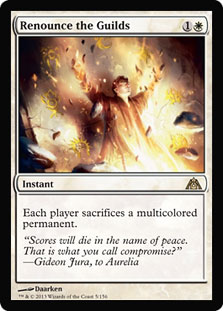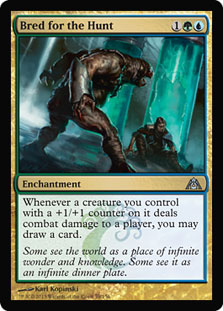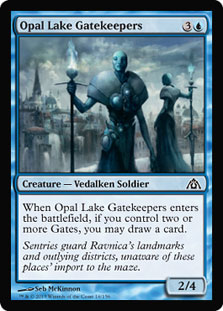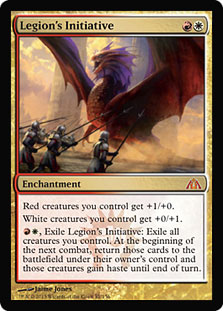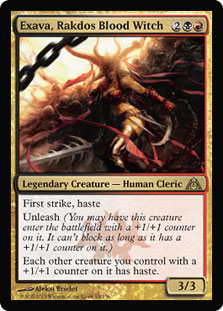Good morning!
I wish I had a great tale for you this morning about my PTQ this past weekend; however, I chickened out at the very last moment and audibled to U/W/R Flash instead of playing my preferred Four-Color Wolf Run Zegana deck for fear of a subpar aggro matchup. I then faced five midrange/control decks. I’ve really got to stop audibling! It never works out!
Quick aside before we get into the Dragon’s Maze spoilers: I found that the U/W/R deck overperformed when it drew a decent mix of spells and lands. I felt I could (and did) win when I drew that decent mix. Conversely, it felt as if I was fighting an extreme uphill battle when I drew any less than optimally. Now, I definitely had my fair share of negative variance (no less an authority but Jarvis Yu came by after my second loss and said, “There was no way you could have won there with the cards you drew”), but even when it was just slightly less than optimal, it still felt uphill. Not impossible, mind you, and I’m sure there exists plenty of small errors or oversights within my games that gave away those small percentage points that led to the feeling of being behind, but that’s just how it felt to me.
Also, at the same PTQ, Brian Braun-Duin finally took one down (when I arrived, I told my buddy Rob that if I were a betting man I’d be quite willing to put my money on BBD taking it down, and I would’ve been right). Congrats to him; BBD making the Top 8 of literally everything he does these days shows me that my complaints about variance (like the ones I made above) are probably just dead wrong and I messed up along the way somewhere.
Anywho, back to the topic at hand. Spoiler season is in full swing, and the wonderful folks over at Wizards are throwing us bones one night at a time. I’m sure everyone has gone really far in-depth on the split card Glimpse // Call (I’m sure that’s what it’s called at this point) as well as some of the “champions” being spoiled. I’m going to look at some of the other cards and applications and see if we can find room within this jammed Standard format for some of these new pieces of cardboard.
Renounce the Guilds
I’ve not really heard anyone discussing this card at all honestly, and that surprises me. “Uncommon at best, waste of a rare slot, this seems terrible…” are some of the comments on StarCityGames.com Facebook page in reference to this. In all honesty, those comments are on every single card ever, but I haven’t really heard anyone excited about the card.
It just seems that they’re not thinking about how good this could be. I even feel it could be a fringe maindeck card in a dedicated control list. Why, might you ask?
Cards Reliably Answered by RtG
Geist of Saint Traft
Obzedat, Ghost Council
Olivia Voldaren
Detention Sphere
Evil Twin
Cards RtG Could Answer
Domri Rade
Aurelia, the Warleader
Assemble the Legion
Falkenrath Aristocrat
Sorin, Lord of Innistrad
Huntmaster of the Fells
Boros Reckoner
Deathrite Shaman
Vraska the Unseen
Lotleth Troll
Duskmantle Seer
Cards I’m Not Sure About
Ral Zarek
Tajic, Blade of the Legion (if somehow it gets played, though I doubt it since it’s in the same block as Azorius Charm)
Voice of Resurgence
The first three cards in the first list are why I initially got excited about the possibility of playing Renounce the Guilds. Having one card that reliably answers both Geist of Saint Traft and Obzedat, Ghost Council is absolutely huge. Having an answer that can’t be stopped by Restoration Angel is equally awesome. Additionally, in decks that play white I’m fairly certain they would be very willing to trade off that Burning Tree Emissary to kill off an Olivia Voldaren reliably.
The other two cards in that list are just cards that I thought you could reliably answer with a Renounce because of the lack of additional multicolored cards in the lists that run them (namely Esper Control). I wouldn’t run Renounce solely for those cards, mind you, but it is a plus.
The next list is a list of cards that you’d be ok or happy with removing with a Renounce the Guilds but I’m not sure it’d be so easy to do. Domri Rade usually gives control decks fits; the problem is that those decks also tend to run Burning Tree Emissary, giving them free protection from Renounce until you can answer that Emissary. (If you have to spend a real card to get rid of a free 2/2 to set up a way to kill Domri Rade, I’m sure Naya would be ok with that before you yell at me that Esper can easily kill a 2/2). Ditto with Aurelia, as those decks tend to run either Boros Reckoner (another card in the list) and/or Burning Tree Emissary and Domri Rade. You could set up a kill with Renounce the Guilds by keeping the other multicolored permanents off the board; it’s just not as reliable.
Another card that got me excited about Renounce the Guilds was Assemble the Legion, another card that gives control fits. The reason it’s in the second list is that if it lives for even one turn, the tokens it produces give Assemble built-in protection. Renounce the Guilds does give you a way to remove an Assemble after a Supreme Verdict though, so that’s a thing.
The wonderful thing about Renounce the Guilds is that it says “sacrifice”; that means that you can set up a blowout by prodding your opponent to sacrifice their creatures to make Falkenrath Aristocrat indestructible then playing Renounce. The problem is that Aristocrat sees play in two decks mainly right now: The Aristocrats and Jund Aggro, both of which have a large number of multicolored creatures, making Renounce a very unreliable answer. However, the cards that The Aristocrats plays that can be killed by Renounce you’re never totally unhappy to kill. Even Cartel Aristocrat can give you problems, and if you get Sorin, Boros Reckoner, or Falkenrath Aristocrat, you’re probably pretty happy.
Unfortunately, Jund Aggro plays Deathrite Shaman, Rakdos Cackler, and Dreg Mangler. It’ll take some setup to get a worthwhile use out of Renounce (at least getting the card you want to get, Falkenrath Aristocrat). Luckily, you still have the “Verdict then Renounce” sequence, but unfortunately you may not have the time.
Another card that is starting to see play against control is Vraska the Unseen in Jund Midrange sideboards. This is another great “target” for Renounce since the deck that plays it will typically remove the only other multicolored permanent (Olivia) post-board and bring in Vraskas.
The last list is just a list of cards in the new set that I could see a good use for Renounce against, but since we have no idea how they’ll be used just yet, I don’t know how reliable Renounce the Guilds will be against them.
Bred for the Hunt
This is another card that isn’t really turning any heads in the competitive crowd (though I’ve heard some rumblings from the Commander community). However, I think it fits in quite nicely with another deck idea I’d been brewing before the Dragon’s Maze spoilers began: RUG Aggro. Everyone’s aware of the presence of Jund Aggro because it’s been a thing since Gatecrash’s release. A couple of weeks in, I had the idea to look into blue over black in the deck since it gives you access to a slightly different angle of attack. Now, I honestly believed that angle to be inferior to the options given in black (namely Falkenrath Aristocrat), but Bred for the Hunt gives me motivation to look into this idea once again.
The first thing you have to come to terms with if you’re going to play a Bred for the Hunt deck is that you’re going to have to play some creatures that you might have better options than just to turn the Hunt on. What are some creatures we could run in this deck?
Rakdos Cackler
Stromkirk Noble
Cloudfin Raptor
Experiment One
Gore-House Chainwalker
Gyre Sage
Master Biomancer
Quirion Dryad
Shambleshark
Slitherhead
Strangleroot Geist
Zameck Guildmage
Primordial Hydra
Now, that’s not to say that we solely run creatures that are good with Bred for the Hunt in play, but rather that we lean towards the options in that list if the comparison is close with other creatures that serve the same role. For instance, we might debate between Flinthoof Boar and Gore-House Chainwalker; I’m not saying we cut the Flinthoof Boars, but if we need to cut some cards, we might lean towards shaving Boars before Walkers in this particular deck.
That may seem sacrilegious to the Jund and R/G Aggro players out there who love the boar (again, not saying we don’t run it, just that we might prefer the Walker in this deck), but think about it this way: Ophidian was a huge card back in the day (albeit in a completely different type of deck). Imagine if we could turn all (or most) of our aggressive creatures into Ophidians that still get to deal damage.
Once our opponent is on to our plan (in other words, after we play Bred for the Hunt), they’re sure to try to prevent us from being able to go hunting for more cards in future turns by either blocking or removal spells. This should play into our thought processes in two ways.
First, we need to think of Bred for the Hunt less as a consistent card draw engine and more of a one-time, one-shot card draw that has potential to draw more cards later as a bonus. In other words, on a board with creatures who already have counters on them, dropping Bred for the Hunt will either cause incredibly awkward blocking for the opponent or draw you some number of cards. For three mana, drawing two or three cards the turn it comes into play while still providing potential advantages later in the game is a good deal, especially when there are no additional mana requirements to gain additional advantages later in the game.
Second, we need to imagine the board state after this card resolves; our opponent isn’t going to want us to draw additional cards from Bred for the Hunt after we get our initial “reward” from casting it. Since most of Standard involves decks that want to play creatures to block, our opponents are likely going to either leave creatures back or leave mana up for Restoration Angel (or Advent of the Wurm). We’re going to need to be ready for this with ways to press our advantage, and we’ll need to build our deck accordingly.
Some of the ways we can press our advantage on a board state with creatures left back to block are:
Ghor-Clan Rampager
Increasing Savagery
Mark of Mutiny
Hands of Binding
Blustersquall
Gruul Charm
Inaction Injunction
Madcap Skills
Mugging
Rancor
Sleep
Spectral Flight
Teleportal
Volcanic Strength
With Mark getting the nod over other Threaten effects simply because of the ability to cantrip with Bred for the Hunt in play. Obviously we’re not running all (or even close to all) of these cards/effects; we’re just trying to get the juices flowing on ideas. Remember, while some of these cards seem like inherent card disadvantage (Hands of Binding and similar effects come to mind). With a Bred for the Hunt in play, they essentially become cantrips, giving you the option of exchanging their effect for another activation of Bred for the Hunt. Obviously this requires Bred for the Hunt to be in play, but it’s not like Hands of Binding is terrible in an aggressive deck by itself anyway.
The one issue with decks like this is that sometimes people will go too far down the “rabbit hole” trying to build the deck to be good when the namesake enchantment is in play. I think that in order to build a successful deck, you need your deck to be good regardless of the presence of the namesake card. Cards like Heartless Summoning come to mind, where the decks that contain them are excellent when the card is in play and nigh unplayable when it is not.
We want to be a RUG Aggro deck first and foremost with the added utility of having a card like Bred for the Hunt be a card advantage engine for our deck. Keep that in mind if you build a Bred for the Hunt deck in addition to thinking about how that card will affect your opponent’s decisions moving forward after you cast your namesake enchantment.
Another thought that should get some consideration is BUG Aggro, a deck that is already seeing slight success before Dragon’s Maze’s release. I think this could also be a good home for Bred for the Hunt as a two- or three-of since you want to play cards like Zameck Guildmage anyway. This could mean we look to Rakdos Cackler to jump a bit down the rabbit hole, but I think it may merit at least some consideration.
Opal Lake Gatekeepers
The control decks already run a card that they hate, Augur of Bolas, in order to gain value from casting Restoration Angel. Believe me, I cast that card plenty of times this past weekend and whiffed, which is incredibly frustrating. Opal Lake Gatekeepers gives control decks the option of having a decent creature left back on defense (in that Searing Spear can’t remove it and it stonewalls a lot of the creatures in Standard right now) while still cantripping and providing you a great target for Restoration Angel in a control deck that isn’t Augur of Bolas. It also isn’t multicolored in case Renounce the Guilds is something you want to be doing, which isn’t completely irrelevant either. This may be stretching a bit too far since you have to run Guildgates and it costs four, but it is something to keep in mind.
The white Gatekeeper isn’t a bad option either; think of it as a poor man’s Huntmaster of the Fells in decks that can’t cast the Huntmaster.
Legion’s Initiative
This card just seems insane! I may be doing a bit of Evan Erwin Magic Show hyperbole here, but it truly does seem like a ridiculous collection of abilities on one card. First, it provides a tangible benefit up front in the damage increase; second, as long as you keep up two mana from turn four on, your opponent is going to have a really hard time Wrathing your board. Even countering one-for-one removal spells seems really sweet, in addition to giving your creatures pseudo-vigilance in aggro mirrors. Your opponent miracles a Bonfire? No problem, your dudes will be back soon enough to mop up what they started. Mizzium Mortars? Nice six mana do-nothing, bro!
Even better than all that? It Blinks your creatures! We all know how ridiculous Restoration Angel is; imagine having the ability to replicate that every single turn! In Naya decks, you get to perma-Blink your Thragtusks and Huntmasters. (Though it’s not super amazing since you do lose your tokens if they’re already in play. You can wait and activate this after your Huntmaster flips, though, removing something and shocking your opponent.) You thought G/B/W Reanimator was obnoxious in its ability to chain Acidic Slimes together!? Wait until this gets online; it’s like a much cheaper Deadeye Navigator that has other uses! In U/W/R decks, you can keep Blinking your Augurs and Snapcasters for more and more value.
This is the card I’m probably most excited about with the first wave of spoilers (it’s between this and Ral Zarek, which fits the type of deck I like playing quite a bit). It just seems like it’s twelve shades of ridiculous, and I’m a fan.
Exava, Rakdos Blood Witch
This is a card that most people are dismissing as suboptimal versions of other cards available at that casting cost. While I agree that Falkenrath Aristocrat and Hellrider are pretty insane, I’d like to think this card has a place somewhere. It is most likely going to get relegated to the back seat before rotation, but I think that once the Vampires and Devils rotate people are going to realize this card is a powerhouse that they should have looked into beforehand. The same thing happened with Hellrider, if you remember, when it was spoiled and people declared it a worse Hero of Oxid Ridge. People are incredibly slow to change until forced to (in this case by rotations), but I think this card will have its day. 4/4 haste with first strike that also gives your other creatures haste!? I think I’d sign up for that…
That’s all for this week. Thanks for reading! I’m unable to play in the WMCQ this weekend in Washington, DC due to my yearlong hiatus from the game (preventing me from qualifying on Planeswalker Points), but I’m debating coming to the side events on Sunday. If I see you there, come up and say hi; I always enjoy meeting readers!
Until next time,
Michael Martin

